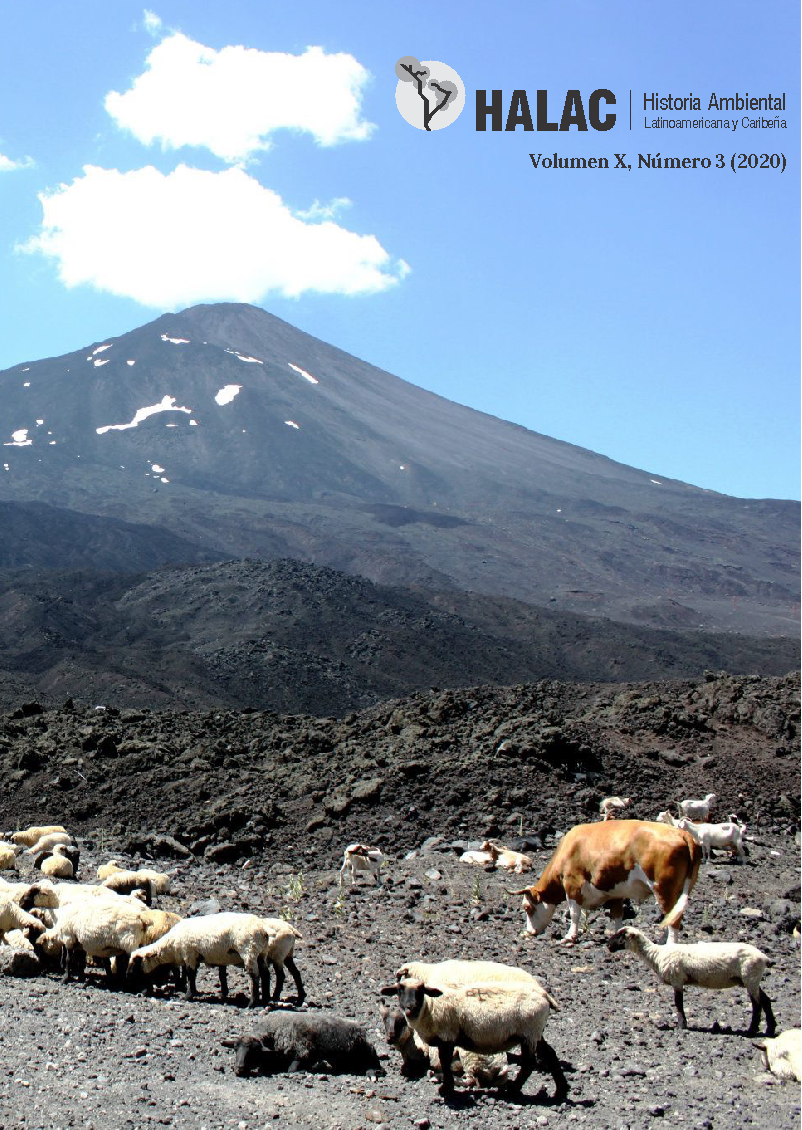The experience of the Legal Reserve in Brazil: a conservation option in rural properties.
DOI:
https://doi.org/10.32991/2237-2717.2020v10i3.p300-318Keywords:
Brazil, landscape planning, environmental policy, sustainabilityAbstract
The Legal Reserve (LR) is a protection tool oriented to conserve part of the natural resources within rural properties in Brazil. For almost a century, it has been the centre of debates between farmers and environmentalists. Through a literature review, this study explains the evolution of the LR highlighting its contributions, even for agriculture. Currently, part of farmers supports the LR in response to markets that demand more sustainable behavior. With 100% of properties with registered LR and 80% compliance with regulations, the LR begins to fulfill its function. A better understanding of this instrument allows other countries to assess its potential use as a conservation tool.
References
Azevedo, Andrea A., Raoni Rajão, Marcelo A. Costa, Marcelo C. C. Stabile, Marcia N. Macedo, Tiago N. P. dos Reis, Ane Alencar, Britaldo S. Soares-Filho, y Rayane Pacheco. «Limits of Brazil’s Forest Code as a Means to End Illegal Deforestation». Proceedings of the National Academy of Sciences 114, Vol29 (18 de julio de 2017): 7653-7658. doi:10.1073/pnas.1604768114.
Azevedo, Andrea A., Marcelo C. C. Stabile, y Tiago N. P. Reis. «Commodity Production in Brazil: Combining Zero Deforestation and Zero Illegality». Elementa: Science of the Anthropocene 3 (2 de diciembre de 2015): 1-12. doi:10.12952/journal.elementa.000076.
Castro, Daniel Stella. «A instituição da Reserva Legal no Código Florestal brasileiro: fundamentos histórico-conceituais». Geography Department, University of Sao Paulo, 2013: 132-54. doi:10.7154/RDG.2013.0026.0007.
CEPEA. «PIB do agronegócio brasileiro», 2019. www.cepea.esalq.usp.br/br/pib-do-agronegocio-brasileiro.aspx.
Coalizão Brasil. «Em defesa do código florestal», 2019. http://www.coalizaobr.com.br/home/emdefesadocodigoflorestal.
Conservation International, y World Wildlife Fund. «PADDDtracker.org Data Release Version 2.0 (May 2019). Arlington, VA: Conservation International. Washington, DC: World Wildlife Fund.», 2019.
Duffy, Philip B., Paulo Brando, Gregory P. Asner, y Christopher B. Field. «Projections of Future Meteorological Drought and Wet Periods in the Amazon». Proceedings of the National Academy of Sciences 112, Vol43 (27 de octubre de 2015): 13172-77. doi:10.1073/pnas.1421010112.
Kengen, Sebastião. «A política florestal Brasileira: uma perspectiva histórica». Porto Seguro, Brasil: Instituto de Pesquisas e estudos Florestais, 2001.
Lei n° 4.771/1965, de 15 de septiembre de 1965. Código Florestal. Presidência da República. http://www.planalto.gov.br/ccivil_03/leis/l4771.htm.
Lei no 12.651/2012, de 25 de mayo de 2012. Código Florestal. Presidência da República. http://www.planalto.gov.br/ccivil_03/_ato2011-2014/2012/lei/l12651.htm.
Mascia, Michael B., y Sharon Pailler. «Protected Area Downgrading, Downsizing, and Degazettement (PADDD) and Its Conservation Implications: PADDD and Its Implications». Conservation Letters 4, Vol1 (febrero de 2011): 9-20. doi:10.1111/j.1755-263X.2010.00147.x.
Medeiros, Rodrigo, y Marta Irving. «A proteção da natureza no Brasil: evolução e conflitos de um modelo em construção». RDE-Revista de Desenvolvimento econômico 6, Vol9 (2004): 11.
Metzger, Jean P. «Bases biológicas para Reserva Legal». Ciência Hoje 31, Vol 183 (junio de 2002): 48-49.
Moutinho, Paulo, IPAM, IMAZON, GREENPEACE, IMAFLORA, ICV, ISA, TNC, y WWF. «A Pathway to Zero Deforestation in the Brazilian Amazon Full Report», 2017, 33.
Rajão, Raoni, Vinícius Faria, Tomás Carvalho, Felipe Cerignoni, Isabella Granero, Luís Fernando Guedes Pinto, Vivian Ribeiro, et al. «A quem interessa a MP 867 do Código Florestal?» Observatorio do Código Florestal, 2019.
Rivera, Claudio, y Arturo Vallejos-Romero. «La privatización de la conservación en Chile: repensando la gobernanza ambiental». Bosque (Valdivia) 36, Vol 1 (2015): 15-25. doi:10.4067/S0717-92002015000100003.
Santiago, Thaís Muniz Ottoni, José Luiz Pereira de Rezende, y Luís Antônio Coimbra Borges. «A evolução da reserva legal: fundamentos para análise e compreensão do instrumento». Ciência Rural 47, Vol 2 (2017): 237-264. doi:10.1590/0103-8478cr20141349.
SFB. «Cadastro Ambiental Rural Boletim Informativo». Datos hasta 31 de julio de 2019, 2019. http://www.florestal.gov.br/documentos/car/boletim-do-car/4211-boletim-informativo-julho-de-2019/file.
Silva, Benedito, Claudia Azevedo-Ramos, y Hilder Farias. «The impact of decentralization policies: the environmental performance applied to mucipalities of the Amazon». Desenvolvimento e meio ambiente 51 (agosto de 2019): 202-223.
Sociedade Brasileira para o Progresso da Ciência, y Academia Brasileira de Ciências. O Código Florestal e a Ciência: contribuições para o diálogo. SBPC., 2012. http://www.sbpcacervodigital.org.br/bitstream/20.500.11832/2634/2/Livro%20CodigoFlorestal__2aed.pdf.
Stabile, Marcelo C. C., André L. Guimarães, Daniel S. Silva, Vivian Ribeiro, Marcia N. Macedo, Michael T. Coe, Erika Pinto, Paulo Moutinho, y Ane Alencar. «Solving Brazil’s Land Use Puzzle: Increasing Production and Slowing Amazon Deforestation». Land Use Policy, 19 de noviembre de 2019, 104362. doi:10.1016/j.landusepol.2019.104362.
UNEP-WCMC. «Protected Area Profile for Latin America & Caribbean from the World Database of Protected Areas, September 2019», 2019. www.protectedplanet.net.
UNEP-WCMC, y IUCN. Protected Planet Report 2016. UNEP-WCMC and IUCN: Cambridge UK and Gland, Switzerland., 2016.
Pádua, José Augusto. “Os Fundamentos Históricos Da Conservação Florestal No Brasil.” In Ensaios Em Ciências Ambientais: Crises, Riscos e Racionalidades, editado por Sandro Dutra e Silva, 185–216. Rio de Janeiro: Garamond, 2016.
Soares-Filho, Britaldo, Raoni Rajão, Marcia Macedo, Arnaldo Carneiro, William Costa, Michael Coe, Hermann Rodrigues, and Ane Alencar. “Cracking Brazil’s Forest Code.” Science 344, no. 6182 (Abril 25, 2014): 363–64. doi:10.1126/science.1246663.
Sparovek, Gerd, Göran Berndes, Alberto Giaroli de Oliveira Pereira Barretto, and Israel Leoname Fröhlich Klug. “The Revision of the Brazilian Forest Act: Increased Deforestation or a Historic Step towards Balancing Agricultural Development and Nature Conservation?” Environmental Science & Policy 16 (Febrero 2012): 65–72. doi:10.1016/j.envsci.2011.10.008.
Downloads
Published
How to Cite
Issue
Section
License
This journal offers immediate free access to its content, following the principle that providing free scientific knowledge to the public provides greater global democratization of knowledge.
As of the publication in the magazine the authors have copyright and publication rights of their articles without restrictions.
The HALAC Magazine follows the legal precepts of the Creative Commons - Attribution-Non-Commercial 4.0 International license. 




